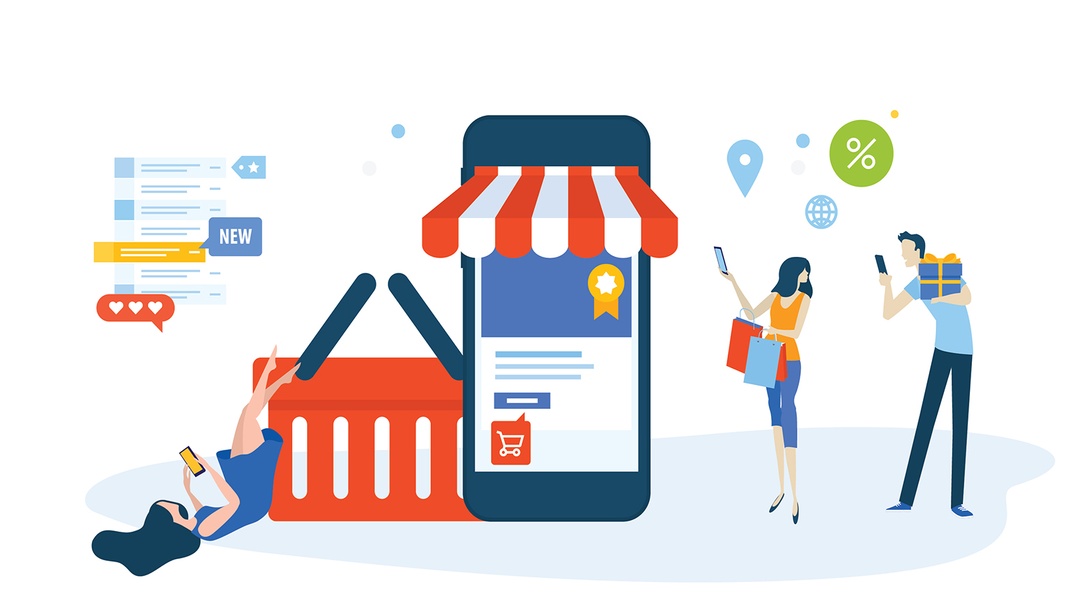It’s not an exaggeration to say that mobile shopping has revolutionized (or rather, is in the process of revolutionizing) the world of commerce as we know it.
From 2013 to where we are today, we’ve seen a steady rise in mobile eCommerce sales, particularly for retail sectors. Back in 2013, mobile retail eCommerce sales in the United States were just over $41 billion. This is an impressive enough total, given that m-commerce barely existed a decade prior. But when we look at the broader m-commerce landscape, its meteoric growth is undeniable: 2018 saw mobile retail eCommerce sales to the tune $207B—five times as high as 2013!
It’s getting big and it’s growing fast. Today’s consumers are accustomed to the convenience of online shopping, and if you’ll allow us to preach for a second, it’s not hard to see why the trend is so sticky.
The Push Towards Mobile Commerce
Mobile shopping is addictive. There’s something intoxicating about the convenience of ordering food, books, clothes, whatever, from the comfort of our couches, and once we start, it’s hard to go back. Consumer research suggests that by 2021, more than half of all retail eCommerce sales will be made through mobile.
Of course, there’s more to mobile shopping’s rise than the convenience aspect. Mobile is just plain useful for empowering customers to make informed decisions. Many of us consult our phones for every aspect of the buyer’s journey, from product research to price comparison to purchase. Heck, we’ll even use them as a supplement to our physical shopping experience! One survey from Google found that 82% of smartphone users consult their phones to help make purchases in-store.
Based on this, we can see that mobile is becoming inexorably tied to commerce, both in direct m-commerce sales and in the larger retail landscape overall. (Going really broad for a moment, consider research by Forrester indicating that smartphone usage played a role in over $1 trillion worth of U.S. retail sales in 2018.) In other words, mobile shopping doesn’t just involve phone purchasing proper—it’s a much broader part of a company’s omnichannel marketing strategy.
Now, if we had to distill all of the above into one succinct sentence (which we don’t, but let’s try it anyway), it’d be this: In the m-commerce world, there’s lots of money flying around—and lots of opportunity for retailers to provide better experiences to their customers.
And given that there’s so much opportunity here, we’re seeing a commensurate rise in the number of mobile applications, platforms, and tools that facilitate these transactions.
Key Points to Consider:
- Has your audience and user base transitioned to mobile? Have you reviewed your user profiles – mobile vs. desktop?
- Just like it’s always a good idea to browse and shop your own website, it’s also critical to review it on a mobile device.
For Merchant, More Mobile Commerce Decisions Than Ever Before
Mobile shopping is a highly competitive space, especially with big market players like Amazon dominating on price…availability…delivery speed…and just about everything else. And with so much money at stake, companies are pulling out all the stops to provide the type of personalized, simple shopping experiences that customers expect.
On the frontend, we have branded mobile apps, optimized mobile webpages, and progressive web apps that mimic native applications. Each of these can be adapted to deliver the precise type of experience a target audience may want—provided that the backend can be adapted in turn. On the store managed experiences, there are also going to be online marketplace integration opportunities (Amazon, NewEgg, and Wal-Mart, for example).
And yet, this simple proviso is where traditional eCommerce platforms start to show their flaws. The consumer-facing side of eCommerce is one thing, but as retailers know, the backend tends to be a bit more complicated. Even small eCommerce stores have a whole host of interconnected systems working behind the scenes to make sales possible.
Integrations with your CMS, ordering systems, payment processing, and marketing systems are all examples—never mind further integrations with your vendors, distributors, or warehousing systems. There’s a lot to keep track of, and when you start going beyond the basic and integrating specific APIs designed to make buying easier, things get more complicated still.
(For example, Facebook’s buy button allows customers to purchase store items directly through Facebook but requires dedicated integration between Facebook and your eCommerce backend).
These challenges can limit a retailer’s capabilities to provide competitive customer experiences—particularly when they’re working with tightly-integrated eCommerce architecture. This limitation translates to real money left on the table; in one study, 87% of customers who had a “very good” experience were very likely to purchase more from the company.
Key Points to Consider:
- The importance of your channel plan can’t be overstated. Where are you selling now? Where would you like to be selling in the future?
- Are you optimizing customer experience through multiple types of purchasing or front ends (B2B2C, subscription offerings, spin-off stores)?
Better Experiences Through Headless Commerce Platforms
The growth of these options presents challenges and opportunities in equal measure. eCommerce providers can reach their audiences in new ways, but they need the means to do so. And when it comes to modern eCommerce solutions, headless architecture offers a different approach.
Traditional eCommerce platforms operate under a strict model of tight front and backend integration, often requiring a middle layer to facilitate communication between the two. But when a company’s backend commerce functions are closely tied to the frontend presentation layer, it drastically limits the ways that the platform can be adapted to suit different customers’ needs.
And in the context of m-commerce, things get trickier still. True omnichannel experiences (that fabled “deliver anywhere” concept) are hard to manage without optimal connections between mobile and web experiences.
But by separating the two, companies eliminate this complexity and can make changes to each layer as needed. It becomes far easier to integrate new APIs, build out marketing channels, and fine-tune customer experiences from both the front and back end. It’s not so much a “new” way of looking at mobile commerce as much as it is the logical progression of omnichannel marketing.
So, with that in mind, we ask: Is headless the only way forward?
Perhaps not the only way. But with consumer preference for mobile well-established in the commerce world, there’s no arguing that companies need simple ways to bring their time-tested web experiences to their customers’ phones. And on that score, headless offers the best blend of simplicity and convenience that you’re likely to find from a modern eCommerce solution.
The Bottom Line
Whether you’re reviewing eCommerce plans for this year or looking towards the future, you’re probably seeing the huge impact that changing customer shopping habits are having on the way we think about eCommerce. Whether it’s consumer products or industrial widgets, you’re already selling differently now than you were a few years ago. That being said, is your business well-positioned to meet these shifting consumer expectations? Are you being held back or slowed down by your eCommerce platform infrastructure? If so, now is the time to explore your options and create a plan to build a foundation to craft the type of experiences that will help your company grow.


